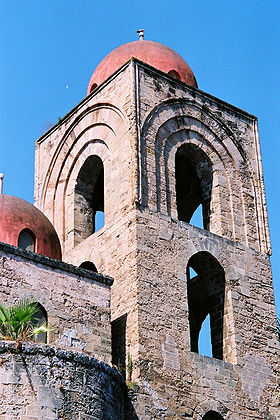
San Giovanni degli Eremiti
Encyclopedia


Palermo
Palermo is a city in Southern Italy, the capital of both the autonomous region of Sicily and the Province of Palermo. The city is noted for its history, culture, architecture and gastronomy, playing an important role throughout much of its existence; it is over 2,700 years old...
, southern Italy
Italy
Italy , officially the Italian Republic languages]] under the European Charter for Regional or Minority Languages. In each of these, Italy's official name is as follows:;;;;;;;;), is a unitary parliamentary republic in South-Central Europe. To the north it borders France, Switzerland, Austria and...
, near the Palazzo dei Normanni
Palazzo dei Normanni
The Palazzo dei Normanni or Royal Palace of Palermo is a palace in Palermo, Italy. It was the seat of the Kings of Sicily during the Norman domination and served afterwards as the main seat of power for the subsequent rulers of Sicily...
.
History
The church's origins date to the 6th century. Later, after the Islamic conquest of Sicily, it was converted into a mosque. After the establishment of the Norman domination of southern Italy, it was returned to the Christians by Roger II of SicilyRoger II of Sicily
Roger II was King of Sicily, son of Roger I of Sicily and successor to his brother Simon. He began his rule as Count of Sicily in 1105, later became Duke of Apulia and Calabria , then King of Sicily...
who, around 1136, entrusted it to the Benedictine monks of Saint William of Vercelli
Monte Vergine
The Benedictine Williamites, more often known by the name of its chief house, Territorial Abbey of Montevergine in central Italy, was a Catholic monastic order....
.
The church was extensively modified during the following centuries. A restoration held around 1880 attempted to restore its original medieval appearance.
Architecture
The church is notable for its brilliant red domes, which show clearly the persistence of Arab influences in Sicily at the time of its reconstruction in the 12th century, the Arab-Norman cultureArab-Norman culture
The term Norman-Arab-Byzantine culture, Norman-Sicilian culture or, less inclusive, Arab-Norman culture respectively Norman-Arab culture, refers to the interaction of the Norman, Arab and Byzantine culture following the Norman conquest of Sicily from 1061, to around 1250...
. In his Diary of an Idle Woman in Sicily, F. Elliot described it as "... totally oriental... it would fit well in Baghdad
Baghdad
Baghdad is the capital of Iraq, as well as the coterminous Baghdad Governorate. The population of Baghdad in 2011 is approximately 7,216,040...
or Damascus
Damascus
Damascus , commonly known in Syria as Al Sham , and as the City of Jasmine , is the capital and the second largest city of Syria after Aleppo, both are part of the country's 14 governorates. In addition to being one of the oldest continuously inhabited cities in the world, Damascus is a major...
". However, the red colour of the domes are not original, as they were restored in the present way at the end of the nineteenth century by an architect who found pieces of red plaster on the domes and therefore decided to paint all the domes in red.
The church lies with a flank on a square construction, which was probably a former mosque. The church is on the Latin Cross plan with a nave and two aisles and three apses. Each of the square spans is surmounted by a dome. The presbytery, ending with a niche, has also a dome.
The cloister, enriched by a luxurious garden, is the best preserved part of the ancient monastery. It has notable small double columns with capitals decorated by vegetable motifs, which support ogival arches. It also includes an Arab cistern.

